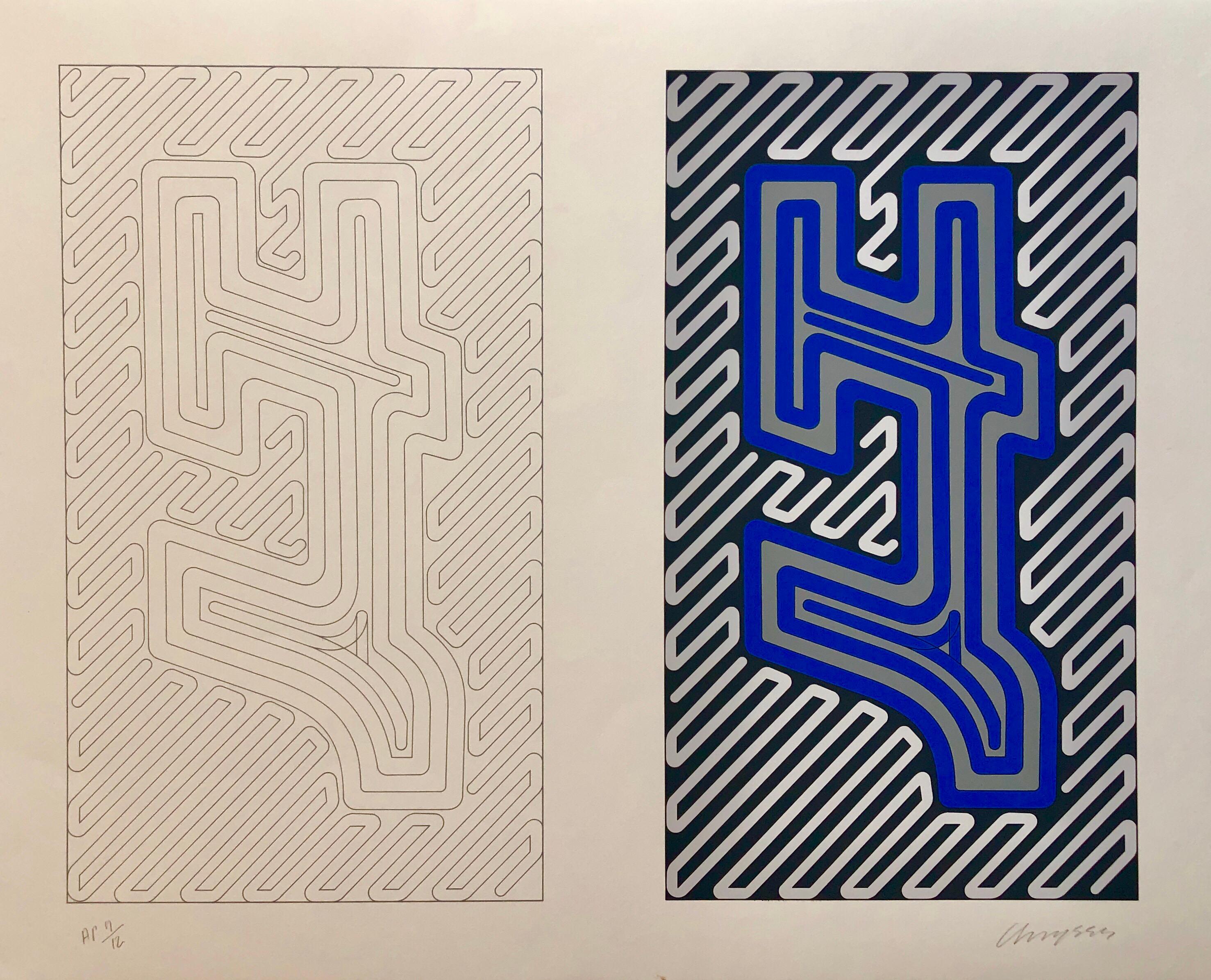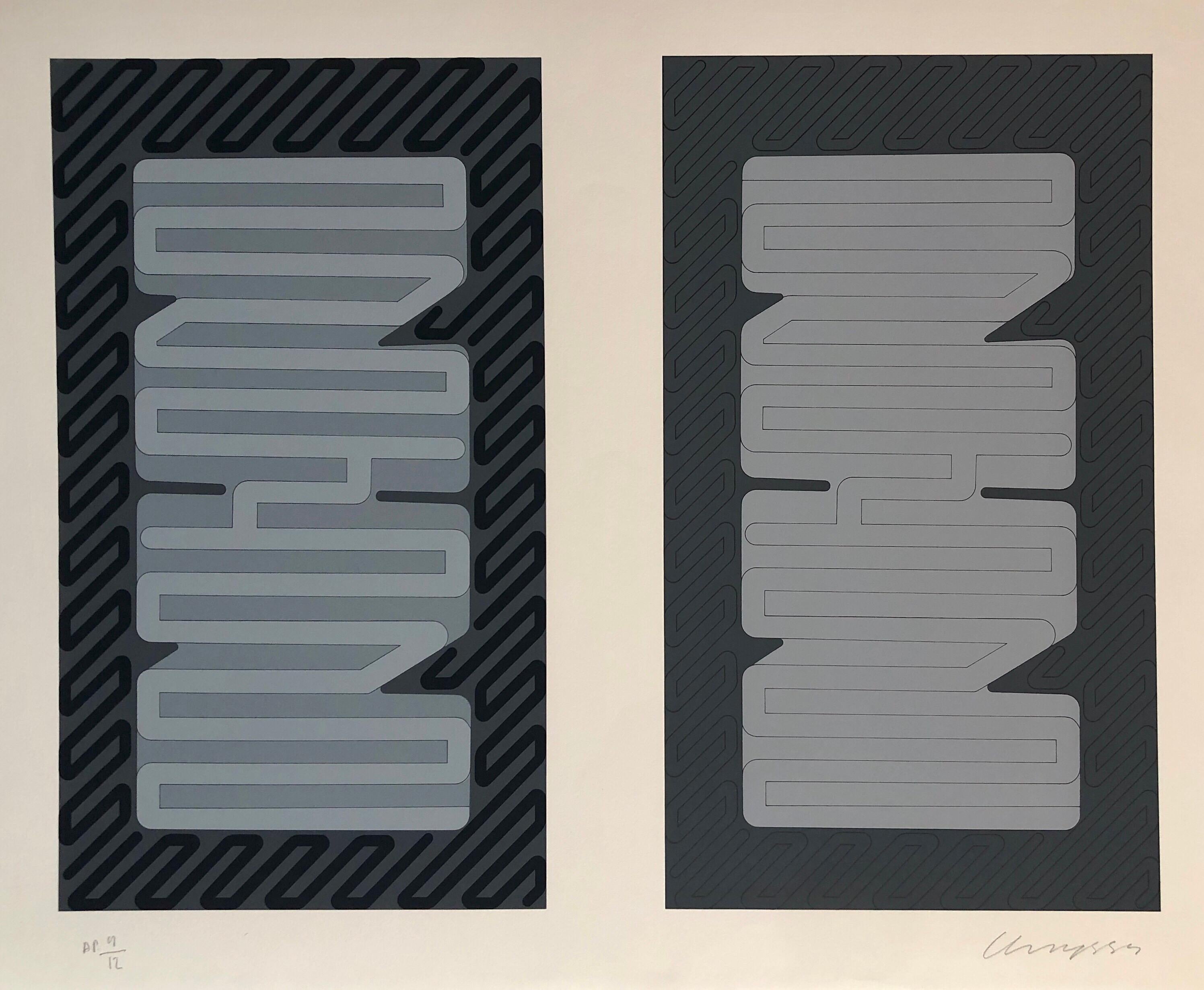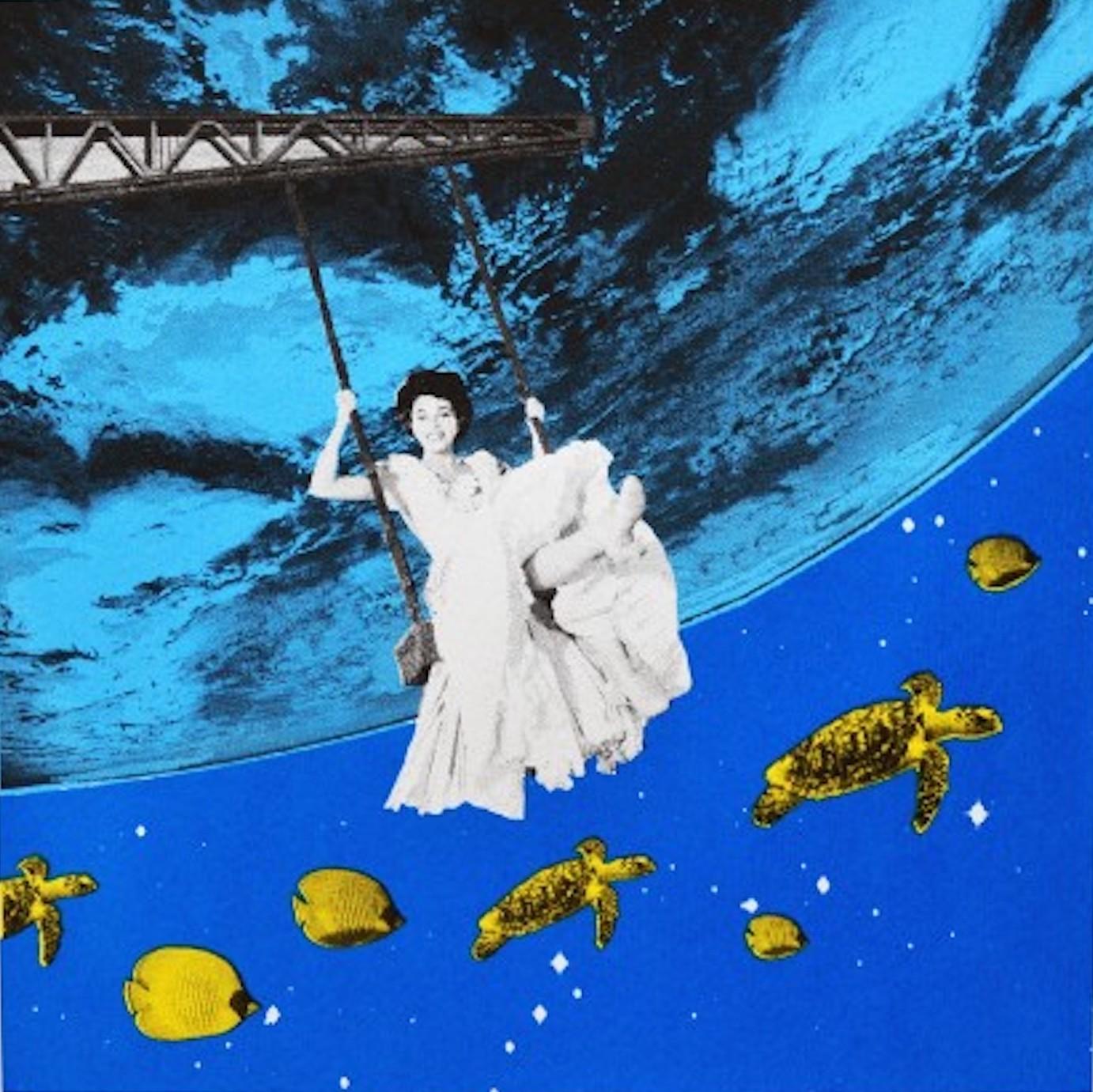Items Similar to 1973 by Mark Lancaster Neon yellow and black British pop art graffiti
Want more images or videos?
Request additional images or videos from the seller
1 of 11
Mark Lancaster1973 by Mark Lancaster Neon yellow and black British pop art graffiti1973
1973
About the Item
A dynamic neon-yellow and black Mark Lancaster screen print combining calligraphic paint strokes, paint drips, and smooth, graphic yellow gradients characteristic of the artist's most well known works such as Cambridge Green (1968). Mark Lancaster studied under Richard Hamilton at King's College, and was the former assistant to Andy Warhol, appearing in several of his films. Later he worked as Jasper Johns' assistant, and then as resident designer with the Merce Cunningham Dance Company where he spent a decade designing sets, costumes, and lighting for various dance works.
1973, 1973
Screen print
Edition of 85 with 9 Artist's Proofs. This copy AP 5/9. Signed and dated lower right, numbered lower left in pencil.
Condition: Lower left corner crease, light creasing along the upper edge, a faint discoloration along the lower edge, and some light edge wear commensurate with age, as photographed.
- Creator:Mark Lancaster (1938 - 2021, British, American)
- Creation Year:1973
- Dimensions:Height: 29.25 in (74.3 cm)Width: 41.25 in (104.78 cm)
- Medium:
- Movement & Style:
- Period:
- Condition:Lower left corner crease, light creasing along the upper edge, a faint discoloration along the lower edge, and some light edge wear commensurate with age, as photographed.
- Gallery Location:New York, NY
- Reference Number:1stDibs: LU1211212189932
About the Seller
5.0
Gold Seller
These expertly vetted sellers are highly rated and consistently exceed customer expectations.
Established in 1968
1stDibs seller since 2019
296 sales on 1stDibs
Typical response time: 8 hours
- ShippingRetrieving quote...Ships From: New York, NY
- Return PolicyA return for this item may be initiated within 7 days of delivery.
More From This SellerView All
- Sightseeing (black pull) James Rosenquist text Pop Art in black and whiteBy James RosenquistLocated in New York, NYThis abstract composition features a cropped view of the words SIGHT SEEING, in bold all-capital lettering. Roses fill the top line of text, and the bottom line of text in white is s...Category
1970s Pop Art Abstract Prints
MaterialsLithograph, Screen
- Sightseeing James Rosenquist text Pop ArtBy James RosenquistLocated in New York, NYSightseeing is one of a group of ten prints which the artist made at Petersburg Press in 1972, each based on one of his paintings. Rosenquist’s Sightseeing 1962 oil painting on canva...Category
1970s Pop Art Abstract Prints
MaterialsLithograph, Screen
- Bunraku, James Rosenquist, abstract Japanese puppetry monochrome Pop ArtBy James RosenquistLocated in New York, NYThis abstract monochrome print portrays large, shiny dark purple bubbles that cascade over a scribbled, dense background. The sense of moveme...Category
Late 20th Century Pop Art Abstract Prints
MaterialsLithograph
- Vintage James Rosenquist poster MOCA Chicago 1972 neon yellow pink chromeBy James RosenquistLocated in New York, NYAn inverted car, gleaming in chrome, speeds through sumptuous layers of pink, translucent yellow, and a veil of lacy, flower-like shapes. Across the top, the artist’s name is splashe...Category
1970s Pop Art Abstract Prints
MaterialsOffset
- Study for Sculpture in the Form of an Inverted Q Above & Below Ground OldenburgBy Claes OldenburgLocated in New York, NYStudy for Sculpture in the Form of an Inverted Q: Above and Below Ground, 1975 Lithograph, soft-ground etching, and aquatint in six colors on cream, thick, slightly textured Rive BFK paper 14 × 11 in. / 35.2 × 28 cm Signed and dated in pencil, lower right, numbered in pencil, lower left. Edition of 100 with 20 AP. Printed by Bill Law, Winston Roeth and Allan Uglow at Petersburg Press...Category
1970s Pop Art Abstract Prints
MaterialsEtching, Aquatint, Lithograph
- Tube James Rosenquist Black and white abstract Pop art chrome based on paintingBy James RosenquistLocated in New York, NYPrinted in the same scale as the original James Rosenquist painting, this black and white, abstract pop art composition features a car door collaged over a gleaming, metallic chrome circle. The shining metal and automobile imagery is characteristic of Rosenquist’s work. Bold, minimalist and monochrome, with a hint of yellow and cobalt blue, Tube's circular composition became a recurring motif for Rosenquist. Circles appear in the artist’s prints from the late 60s – he was interested in the “circles of confusion”, or the phenomenon of a camera lens being pointed directly at the sun. Lithograph based on Rosenquist’s 1963 painting...Category
Late 20th Century Pop Art Abstract Prints
MaterialsLithograph
You May Also Like
- 1970's Large Silkscreen Abstract Geometric Day Glo Serigraph Pop Art Print NeonBy Chryssa Vardea-MavromichaliLocated in Surfside, FLSilkscreen on Arches paper, Hand signed and Numbered in Pencil. Serigraph in blue gray (silver). Chryssa Vardea-Mavromichali (Greek: Χρύσα Βαρδέα-Μαυρομιχάλη; December 31, 1933 – December 23, 2013) was a Greek American artist who worked in a wide variety of media. An American art pioneer in light art and luminist sculpture widely known for her neon, steel, aluminum and acrylic glass installations, she has always used the mononym Chryssa professionally. She worked from the mid-1950s in New York City studios and worked since 1992 in the studio she established in Neos Kosmos, Athens, Greece. Chryssa was born in Athens into the famous Mavromichalis family from the Mani Peninsula. one of her sisters, who studied medicine, was a friend of the poet and novelist Nikos Kazantzakis. Chryssa began painting during her teenage years and also studied to be a social worker.In 1953, on the advice of a Greek art critic, her family sent her to Paris to study at the Académie de la Grande Chaumiere where Andre Breton, Edgard Varese, and Max Ernst were among her associates and Alberto Giacometti was a visiting professor. In 1954, at age twenty-one, Chryssa sailed for the United States, arrived in New York and went to San Francisco, California to study at the California School of Fine Arts. Returning to New York in 1955, she became a United States citizen and established a studio in the city. Chryssa's first major work was The Cycladic Books preceded American minimalism by seventeen years. 1961, Chryssa's first solo exhibition was mounted at The Guggenheim. 1963, Chryssa's work was shown at the Museum of Modern Art in curator Dorothy Canning Miller's Americans 1963 exhibition. The artists represented in the show also included Richard Anuszkiewicz, Lee Bontecou, Robert Indiana, Richard Lindner, Marisol, Claes Oldenburg, Ad Reinhardt, James Rosenquist and others. 1966, The Gates to Times Square, regarded as "one of the most important American sculptures of all time" and "a thrilling homage to the living American culture of advertising and mass communications." The work is a 10 ft cube installation of two huge letter 'A's through which visitors may walk into "a gleaming block of stainless steel and Plexiglas that seems to quiver in the play of pale blue neon light" which is controlled by programmed timers. First shown in Manhattan's Pace Gallery, it was given to the Albright-Knox Art Gallery in Buffalo, New York in 1972. 1972, The Whitney Museum of American Art mounted a solo exhibition of works by Chryssa. That's All (early 1970s), the central panel of a triptych related to The Gates of Times Square, was acquired by the Museum of Modern Art between 1975 and 1979. 1973, Chryssa's solo exhibition at the Gallerie Denise René was reviewed for TIME magazine by art critic Robert Hughes before it went on to the Galleries Denise René in Düsseldorf and Paris. Other works by Chryssa in composite honeycomb aluminum and neon in the 1980s and 1990s include Chinatown, Siren, Urban Traffic, and Flapping Birds. Chryssa 60/90 retrospective exhibition in Athens in the Mihalarias Art Center. After her long absence from Greece, a major exhibition including large aluminum sculptures - cityscapes, "neon boxes" from the Gates to the Times Square, paintings, drawings etc. was held in Athens. In 1992, after closing her SoHo studio, which art dealer Leo Castelli had described as "one of the loveliest in the world," Chryssa returned to Greece. She found a derelict cinema which had become a storeroom stacked with abandoned school desks and chairs, behind the old Fix Brewery near the city center in Neos Kosmos, Athens. Using the desks to construct enormous benches, she converted the space into a studio for working on designs and aluminum composite honeycomb sculptures...Category
1980s Pop Art Abstract Prints
MaterialsScreen
- 1970's Large Silkscreen Abstract Geometric Day Glo Serigraph Pop Art Print NeonBy Chryssa Vardea-MavromichaliLocated in Surfside, FLSilkscreen on Arches paper, Hand signed and Numbered in Pencil. Serigraph in white, back, blue gray (silver). Chryssa Vardea-Mavromichali (Greek: Χρύσα Βαρδέα-Μαυρομιχάλη; December 31, 1933 – December 23, 2013) was a Greek American artist who worked in a wide variety of media. An American art pioneer in light art and luminist sculpture widely known for her neon, steel, aluminum and acrylic glass installations, she has always used the mononym Chryssa professionally. She worked from the mid-1950s in New York City studios and worked since 1992 in the studio she established in Neos Kosmos, Athens, Greece. Chryssa was born in Athens into the famous Mavromichalis family from the Mani Peninsula. one of her sisters, who studied medicine, was a friend of the poet and novelist Nikos Kazantzakis. Chryssa began painting during her teenage years and also studied to be a social worker.In 1953, on the advice of a Greek art critic, her family sent her to Paris to study at the Académie de la Grande Chaumiere where Andre Breton, Edgard Varese, and Max Ernst were among her associates and Alberto Giacometti was a visiting professor. In 1954, at age twenty-one, Chryssa sailed for the United States, arrived in New York and went to San Francisco, California to study at the California School of Fine Arts. Returning to New York in 1955, she became a United States citizen and established a studio in the city. Chryssa's first major work was The Cycladic Books preceded American minimalism by seventeen years. 1961, Chryssa's first solo exhibition was mounted at The Guggenheim. 1963, Chryssa's work was shown at the Museum of Modern Art in curator Dorothy Canning Miller's Americans 1963 exhibition. The artists represented in the show also included Richard Anuszkiewicz, Lee Bontecou, Robert Indiana, Richard Lindner, Marisol, Claes Oldenburg, Ad Reinhardt, James Rosenquist and others. 1966, The Gates to Times Square, regarded as "one of the most important American sculptures of all time" and "a thrilling homage to the living American culture of advertising and mass communications." The work is a 10 ft cube installation of two huge letter 'A's through which visitors may walk into "a gleaming block of stainless steel and Plexiglas that seems to quiver in the play of pale blue neon light" which is controlled by programmed timers. First shown in Manhattan's Pace Gallery, it was given to the Albright-Knox Art Gallery in Buffalo, New York in 1972. 1972, The Whitney Museum of American Art mounted a solo exhibition of works by Chryssa. That's All (early 1970s), the central panel of a triptych related to The Gates of Times Square, was acquired by the Museum of Modern Art between 1975 and 1979. 1973, Chryssa's solo exhibition at the Gallerie Denise René was reviewed for TIME magazine by art critic Robert Hughes before it went on to the Galleries Denise René in Düsseldorf and Paris. Other works by Chryssa in composite honeycomb aluminum and neon in the 1980s and 1990s include Chinatown, Siren, Urban Traffic, and Flapping Birds. Chryssa 60/90 retrospective exhibition in Athens in the Mihalarias Art Center. After her long absence from Greece, a major exhibition including large aluminum sculptures - cityscapes, "neon boxes" from the Gates to the Times Square, paintings, drawings etc. was held in Athens. In 1992, after closing her SoHo studio, which art dealer Leo Castelli had described as "one of the loveliest in the world," Chryssa returned to Greece. She found a derelict cinema which had become a storeroom stacked with abandoned school desks and chairs, behind the old Fix Brewery near the city center in Neos Kosmos, Athens. Using the desks to construct enormous benches, she converted the space into a studio for working on designs and aluminum composite honeycomb sculptures...Category
1980s Pop Art Abstract Prints
MaterialsScreen
- 1970's Large Silkscreen Abstract Geometric Day Glo Serigraph Pop Art Print NeonBy Chryssa Vardea-MavromichaliLocated in Surfside, FLSilkscreen on Arches paper, Hand signed and Numbered in Pencil. Serigraph in black, gray (silver). Chryssa Vardea-Mavromichali (Greek: Χρύσα Βαρδέα-Μαυρομιχάλη; December 31, 1933 – December 23, 2013) was a Greek American artist who worked in a wide variety of media. An American art pioneer in light art and luminist sculpture widely known for her neon, steel, aluminum and acrylic glass installations, she has always used the mononym Chryssa professionally. She worked from the mid-1950s in New York City studios and worked since 1992 in the studio she established in Neos Kosmos, Athens, Greece. Chryssa was born in Athens into the famous Mavromichalis family from the Mani Peninsula. one of her sisters, who studied medicine, was a friend of the poet and novelist Nikos Kazantzakis. Chryssa began painting during her teenage years and also studied to be a social worker.In 1953, on the advice of a Greek art critic, her family sent her to Paris to study at the Académie de la Grande Chaumiere where Andre Breton, Edgard Varese, and Max Ernst were among her associates and Alberto Giacometti was a visiting professor. In 1954, at age twenty-one, Chryssa sailed for the United States, arrived in New York and went to San Francisco, California to study at the California School of Fine Arts. Returning to New York in 1955, she became a United States citizen and established a studio in the city. Chryssa's first major work was The Cycladic Books preceded American minimalism by seventeen years. 1961, Chryssa's first solo exhibition was mounted at The Guggenheim. 1963, Chryssa's work was shown at the Museum of Modern Art in curator Dorothy Canning Miller's Americans 1963 exhibition. The artists represented in the show also included Richard Anuszkiewicz, Lee Bontecou, Robert Indiana, Richard Lindner, Marisol, Claes Oldenburg, Ad Reinhardt, James Rosenquist and others. 1966, The Gates to Times Square, regarded as "one of the most important American sculptures of all time" and "a thrilling homage to the living American culture of advertising and mass communications." The work is a 10 ft cube installation of two huge letter 'A's through which visitors may walk into "a gleaming block of stainless steel and Plexiglas that seems to quiver in the play of pale blue neon light" which is controlled by programmed timers. First shown in Manhattan's Pace Gallery, it was given to the Albright-Knox Art Gallery in Buffalo, New York in 1972. 1972, The Whitney Museum of American Art mounted a solo exhibition of works by Chryssa. That's All (early 1970s), the central panel of a triptych related to The Gates of Times Square, was acquired by the Museum of Modern Art between 1975 and 1979. 1973, Chryssa's solo exhibition at the Gallerie Denise René was reviewed for TIME magazine by art critic Robert Hughes before it went on to the Galleries Denise René in Düsseldorf and Paris. Other works by Chryssa in composite honeycomb aluminum and neon in the 1980s and 1990s include Chinatown, Siren, Urban Traffic, and Flapping Birds. Chryssa 60/90 retrospective exhibition in Athens in the Mihalarias Art Center. After her long absence from Greece, a major exhibition including large aluminum sculptures - cityscapes, "neon boxes" from the Gates to the Times Square, paintings, drawings etc. was held in Athens. In 1992, after closing her SoHo studio, which art dealer Leo Castelli had described as "one of the loveliest in the world," Chryssa returned to Greece. She found a derelict cinema which had become a storeroom stacked with abandoned school desks and chairs, behind the old Fix Brewery near the city center in Neos Kosmos, Athens. Using the desks to construct enormous benches, she converted the space into a studio for working on designs and aluminum composite honeycomb sculptures...Category
1980s Pop Art Abstract Prints
MaterialsScreen
- "Wrapped Statues, Aegina Temple" Large screen print with collage.Located in San Francisco, CAThis artwork titled "Wrapped Statues, Aegina Temple, Project for the Munich Glyptotek" from the "Official Arts Portfolio of the XXIV Olympic" 1988, is an original screen print with c...Category
Late 20th Century Pop Art Abstract Prints
MaterialsScreen
- Bicentennial, by Roy LichtensteinBy Roy LichtensteinLocated in New York, NYIncluded in America: The Third Century portfolio, Roy Lichtenstein created Bicentennial as an original color lithograph with screenprint in 1975, conceived to celebrate the 200th ann...Category
20th Century Pop Art More Prints
MaterialsLithograph, Screen
- Anne Storno, Aquarium, Limited Edition Prints, Surrealist Screen Print, Pop ArtBy Anne StornoLocated in Deddington, GBAnne Storno Aquarium Limited Edition Edition of 14 Image Size: 26 x 26 cm Paper Size: 50 x 50 cm Sold Unframed Please note that in situ images are purely an indication of how a piece may look. A limited edition, hand printed screen print, made in England. This work is inspired by collage and surrealist artworks. I like combining images removed from their original narrative context and reconfigured into a new scenario. Aquarium is mixing an old image of Joan Collins, the actress, with a view of the earth from space...Category
21st Century and Contemporary Pop Art Abstract Prints
MaterialsArchival Paper, Screen
Recently Viewed
View AllMore Ways To Browse
Neon Yellow
Vintage Neon Art
Neon Light Sign
Neon Lighted Signs
A Vintage Neon Sign
Lancaster Vintage
Lancaster And Vintage
1973 Warhol
Richard Hamilton Artist
Vintage Neon Light
Retro Neon Light
Hamilton Pop Art
Graffiti Wear
Vintage Calligraphy Set
John Lancaster
Uk Vintage Map
Vintage Ice Skates
Vintage Railway Carriages




